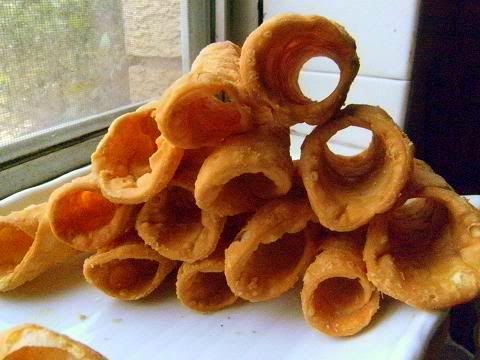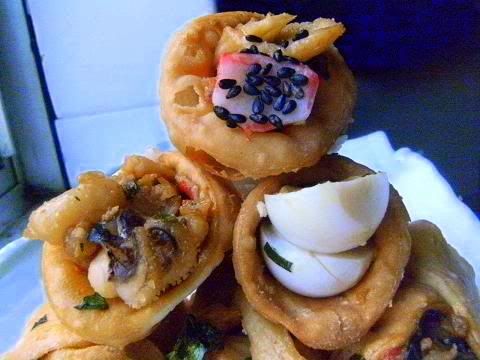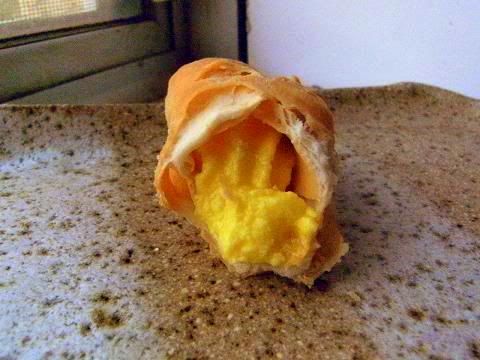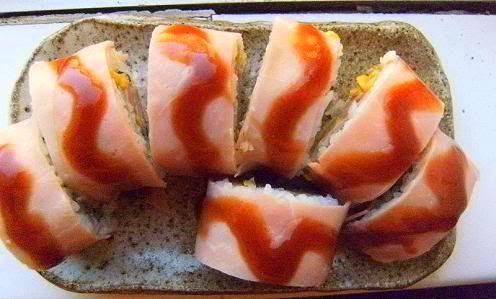Daring Bakers' Cannoli Challenge







The November 2009 Daring Bakers Challenge was chosen and hosted by Lisa Michele of Parsley, Sage, Desserts and Line Drives. She chose the Italian Pastry, Cannolo (Cannoli is plural), using the cookbooks Lidia’s Italian-American Kitchen by Lidia Matticchio Bastianich and The Sopranos Family Cookbook by Allen Rucker; recipes by Michelle Scicolone, as ingredient/direction guides. She added her own modifications/changes, so the recipe is not 100% verbatim from either book..
Cannoli are known as Italian-American pastries, although the origin of cannoli dates back to Sicily, specifically Palermo, where it was prepared during Carnevale season, and according to lore, as a symbol of fertility. The cannoli is a fried, tube-shaped pastry shell (usually containing wine) filled with a creamy amalgamation of sweetened ricotta cheese, chocolate, candied fruit or zest, and sometimes nuts. Although not traditional, mascarpone cheese is also widely used, and in fact, makes for an even creamier filling when substituted for part of the ricotta, or by itself. However, cannoli can also be filled with pastry creams, mousses, whipped cream, ice cream etc. You could also add your choice of herbs, zests or spices to the dough, if desired. Marsala is the traditional wine used in cannoli dough, but any red or white wine will work fine, as it’s not only added for flavor or color, but to relax the gluten in the dough since it can be a stiff dough to work with. By the way, the name ‘Lidisano’ is a combination of Lidia, Lisa and Sopranos..LOL
When I first saw the challenge recipe I thought 'it's deep frying not baking' great I have so little experience with frying wonderful to have an opportunity to gain some experience in this skill.
The dough from the recipe claimed to be very tough and resisted rolling out I didn't find this at all I use red wine instead of marsala maybe that made a difference. I used both cut-up broom handle and pasta shells as my cannoli forms and these worked really well there is no need to buy the fancy metal forms. Also we had the choice to bake them though everybody said the deep fried version was the tastiest.
MY VERDICT – these are excellent and simple to make and are the most delightful dessert but be warned they are very rich and I could only eat one.
A big thank you to Lisa for choosing cannoli. I made 2 dozen large cannoli and 2 dozen mini cannoli for the Melbourne Cup BBQ I'm having. I cut up an old broom handle and an old wooden spoon handle to make the cannoli forms. The dough is very stiff (it feels very odd when you start kneading it) I added a lot of acid to relax the gluten and I found resting the dough for a few hours really helped a lot in rolling and cutting it when I was ready to use it. After the resting the dough is nice and silky. A fairly easy recipe to follow.
Large and small cannoli
Close up of large cannoli
For the Melbourne Cup BBQ I filled each end of with a different filling. So that is ten combinations. I had plenty of nut meal from the last challenge so I used it in the fillings it really adds a lovely depth of flavour and a richness that is unbelievable. These are a very rich dessert. I could only have one (the chocolate hazelnut was absolutely delicious) luckily some friends came over to finish the lot off.
Top row going from left to right - Sour cherry and almond meal and gin in yoghurt curd, lime and cherry with walnut meal and mint in cream cheese.
Bottom row going from left to right - passionfruit with coconut meal and pandan and saffron in sweet feta cheese, chocolate with hazelnut meal, lime and lemon and mint pastry cream. The sour cherry/almond/gin in yoghurt curb was so so so good.
I played around with these flavours for the other end of the cannolo. I think it is good to have a little tartness or tang with these desserts they are so incredibly rich - one is enough. It was nice to have two flavours in one cannolo. I think one end chocolate/walnut and the other end sour cherry/coconut/mint was particularly good.
Passionfruit with coconut meal and pandan and saffron in sweet feta cheese
Lisa Michele these treats are wonderful I can see why so many people rave about them. These are not that common in Australia (I have never seen them in the shops around my area but I'm sure you can get them somewhere) this is one of the more stimulating challenges for me very interesting on many levels (no baking and any filling).
I made some more shells I made two half batches. One batch was made with red wine, and the other batch was made with 25% cocoa. If you make the cocoa shells you will have to deep-fry them at a much lower temperature.

The savoury cannoli I did for the Melbourne Cup BBQ OBTW "Shocking" won.
The fillings are as follows:-
Top – intimation crab and bamboo charred sesame seeds in wasabi leaf cream cheese. You can get real wasabi leaf in my local area!!!!
Middle – (L to R) BBQ octopus in Catalan alloli (made only from garlic, oil and salt), quail egg salad with taramasalata.
Bottom – (L to R) Quail egg/ fish roe with wasabi sesame seeds in yoghurt filling, intimation crab in an oyster cottage cheese filling, mixed seafood salad in ketchup manis with mint and coriander.
Six was an excellent number wow it was tasty, cannoli goes really well with eggs and/or seafood.
Sweet Feta Cheese Recipe
I make it at home I crumble marinated feta cheese (feta cheese in olive oil) and let it seep in a sugar syrup overnight this causes the feta to have a sugary coating with a salty interior, the finer the crumble the better the contrast between sweet and salty. It's an old trick I learnt when I was BBQing watermelon for "Balsamic vinegar BBQed watermelon and feta salad" one of my favourites for a picnic meal. I use it because sweet feta cheese is a taste dilemma for the palate it fools the tongue into believing it is tasting an oscillating contrast between sweet and salty at the same time and of course with the Balsamic vinegar (sour and umami taste sensations) and olive oil (fatty acid taste sensation) makes the picnic salad well balanced in all the taste sensations. Food flavouring is my speciality as you can guess I know a lot about the science and practice of balancing taste sensations in foods.
OBTW passion fruit has some of the same taste sensations as black tea/banana/white wine while coconut has some of the same taste sensations as saffron and pandan - I have found it is best to combine foods with the same taste sensations. There is a very good reason why I combine the flavours I do for the challenge fillings.
Taste sensations
There is a book called 'The flavor bible' which a lot of people rave about here is a typical quote it would be a great place to start
"Upon its own publication in 2008, THE FLAVOR BIBLE is being more readily embraced by fans of CULINARY ARTISTRY as well as others who can appreciate this groundbreaking reference of contemporary compatible flavors that is as useful to anyone who cooks as a thesaurus is to anyone who writes. In addition to being named a Finalist for the 2009 James Beard Book Award, THE FLAVOR BIBLE has appeared on numerous lists of the year's most outstanding culinary books, including those compiled by "Good Morning America" and People magazine as well as About.com, Austin Chronicle, Barbara-Jo's Books to Cooks, Chicago magazine, CoolHunting.com, Fresno Bee, Metroland, Restaurants & Institutions, San Francisco Chronicle, Sarasota Herald-Tribune, SheKnows.com, South Bend Tribune, StarChefs.com, Tucson Citizen, Vancouver Sun, What's Up Anapolis, and many others."
Also there is a great site called foodpairing that lists the taste sensations of food so you can see what food goes with what other food it is quite easy to use which can help you decide what flavour combinations go well . Just enter the food for example
Apple has some of the same taste sensations as Parmesan, Butter, Cheese blue, Tea black, Dominican Republic white chocolate, Tea green and Chardonnay and others
Cinnamon has some of the same taste sensations as Tea green, Tea black amongst others
So you can be sure that apples and cinnamon will work well because they share the same taste sensations of tea green and black tea.
I didn't learn this way I read a lot of scientific papers and worked it out that way and by doing a lot of reading and cooking and baking. Thanks for the kind words. *blushing*
As you know taste is made up of a basic spectrum of sensations so it is possible to reproduce a complex flavour by using other flavour combinations, there is a huge science on this and it has been discovered that Foods combine well with similar flavour sensations for example.
Passion fruit can be replaced with with this combination apricot, black tea, banana, butter and Chardonnay so if I made a layer cake with an outside passion fruit buttercream and the sponges where soaked with Chardonnay and black tea and the inner filling for the cake was an apricot buttercream so this would be an intensely harmonious and intensely tasty.
The science of flavour enhancing and combination is finding the basic flavour sensations for a food and combining these with other foods with similar flavour sensations. There is a huge literature on this. So if I had a normal passionfruit cake a wine I would pick would be Chardonnay since they have a common flavour sensation and so on....
So if I wanted to add extra zing to a basic walnut pastry cream filled canolli coated in dark chocolate the foodpairing site says:-
Walnut can be combined (and has the same flavour sensations) as these
1.Tea black, Dominican Republic white chocolate and Tea green
2.Apple, Apricot and Guava
3.Avocado, Gourmandine potato and Kohlrabi
4.Roast Chicken
5.Cardamom, cilanto and dill
Dark chocolate can be combined (and has the same flavour sensations) as these
Fruits - Strawberry, Coconut and Raspberry
Dairy - Butter, Cheddar and Yoghurt
Meat - Foie de canard Rougié baked, Beef grilled and Chicken cooked
Fish – Cod, and clams
Herbs – Basil, cilantro and ginger
So you could add cardamom and apple to the filling (since these have some of the same taste sensations as walnut) and to the dark chocolate you could add a touch of basil or dill (since these have some of the same taste sensations as dark chocolate). So the final cannoli would be filled with a walnut cardamom and apple pastry cream coated with basil, dill and dark chocolate.
Of course you now understand why basil dark chocolate is so nice since basil and dark chocolate have some of the same taste sensations. And another classic example from the above lists is; Roast chicken, avocado and walnut salad all these ingredients share the same taste sensations so combine and enhance each other.
LIDISANO’S CANNOLI
Makes 22-24 4-inch cannoli
Prep time:
Dough – 2 hours and 10-20 minutes, including resting time, and depending on whether you do it by hand or machine.
Filling – 5-10 minutes plus chilling time (about 2 hours or more)
Frying – 1-2 minutes per cannoli
Assemble – 20–30 minutes
RECIPE NOTE: THE EQUIVALENTS FROM THIS RECIPE WERE PREPARED USING THIS CONVERSION SITE: http://www.gourmetsleuth.com/index.asp.
CANNOLI SHELLS
2 cups (250 grams/8.82 ounces) all-purpose flour
2 tablespoons(28 grams/1 ounce) sugar
1 teaspoon (5 grams/0.06 ounces) unsweetened baking cocoa powder
1/2 teaspoon (1.15 grams/0.04 ounces) ground cinnamon
1/2 teaspoon (approx. 3 grams/0.11 ounces) salt
3 tablespoons (42 grams/1.5 ounces) vegetable or olive oil
1 teaspoon (5 grams/0.18 ounces) white wine vinegar
Approximately 1/2 cup (approx. 59 grams/approx. 4 fluid ounces/approx. 125 ml) sweet Marsala or any white or red wine you have on hand
1 large egg, separated (you will need the egg white but not the yolk)
Vegetable or any neutral oil for frying – about 2 quarts (8 cups/approx. 2 litres)
1/2 cup (approx. 62 grams/2 ounces) toasted, chopped pistachio nuts, mini chocolate chips/grated chocolate and/or candied or plain zests, fruits etc.. for garnish
Confectioners' sugar
Note - If you want a chocolate cannoli dough, substitute a few tablespoons of the flour (about 25%) with a few tablespoons of dark, unsweetened cocoa powder (Dutch process) and a little more wine until you have a workable dough (Thanks to Audax).
CANNOLI FILLING
2 lbs (approx. 3.5 cups/approx. 1 kg/32 ounces) ricotta cheese, drained
1 2/3 cups cup (160 grams/6 ounces) confectioner’s sugar, (more or less, depending on how sweet you want it), sifted
1/2 teaspoon (1.15 grams/0.04 ounces) ground cinnamon
1 teaspoon (4 grams/0.15 ounces) pure vanilla extract or the beans from one vanilla bean
3 tablespoons (approx. 28 grams/approx. 1 ounce) finely chopped good quality chocolate of your choice
2 tablespoons (12 grams/0.42 ounces) of finely chopped, candied orange peel, or the grated zest of one small to medium orange
3 tablespoons (23 grams/0.81 ounce) toasted, finely chopped pistachios
Note - If you want chocolate ricotta filling, add a few tablespoons of dark, unsweetened cocoa powder to the above recipe, and thin it out with a few drops of warm water if too thick to pipe.
DIRECTIONS FOR SHELLS:
1. In the bowl of an electric stand mixer or food processor, combine the flour, sugar, cocoa, cinnamon, and salt. Stir in the oil, vinegar, and enough of the wine to make a soft dough. Turn the dough out onto a lightly floured surface and knead until smooth and well blended, about 2 minutes. Shape the dough into a ball. Cover with plastic wrap and let rest in the fridge from 2 hours to overnight.
2 Cut the dough into two pieces. Keep the remaining dough covered while you work. Lightly flour a large cutting or pastry board and roll the dough until super thin, about 1/16 to 1/8” thick (An area of about 13 inches by 18 inches should give you that). Cut out 3 to 5-inch circles (3-inch – small/medium; 4-inch – medium/large; 5-inch;- large. Your choice). Roll the cut out circle into an oval, rolling it larger and thinner if it’s shrunk a little.
3 Oil the outside of the cannoli tubes (You only have to do this once, as the oil from the deep fry will keep them well, uhh, oiled..lol). Roll a dough oval from the long side (If square, position like a diamond, and place tube/form on the corner closest to you, then roll) around each tube/form and dab a little egg white on the dough where the edges overlap. (Avoid getting egg white on the tube, or the pastry will stick to it.) Press well to seal. Set aside to let the egg white seal dry a little.
4. In a deep heavy saucepan, pour enough oil to reach a depth of 3 inches, or if using an electric deep-fryer, follow the manufacturer's directions. Heat the oil to 375°F (190 °C) on a deep fry thermometer, or until a small piece of the dough or bread cube placed in the oil sizzles and browns in 1 minute. Have ready a tray or sheet pan lined with paper towels or paper bags.
5. Carefully lower a few of the cannoli tubes into the hot oil. Do not crowd the pan. Fry the shells until golden, about 2 minutes, turning them so that they brown evenly.
8. Lift a cannoli tube with a wire skimmer or large slotted spoon, out of the oil. Using tongs, grasp the cannoli tube at one end. Very carefully remove the cannoli tube with the open sides straight up and down so that the oil flows back into the pan. Place the tube on paper towels or bags to drain. Repeat with the remaining tubes. While they are still hot, grasp the tubes with a potholder and pull the cannoli shells off the tubes with a pair of tongs, or with your hand protected by an oven mitt or towel. Let the shells cool completely on the paper towels. Place shells on cooling rack until ready to fill.
9. Repeat making and frying the shells with the remaining dough. If you are reusing the cannoli tubes, let them cool before wrapping them in the dough.
DIRECTIONS FOR FILLING:
1. Line a strainer with cheesecloth. Place the ricotta in the strainer over a bowl, and cover with plastic wrap and a towel. Weight it down with a heavy can, and let the ricotta drain in the refrigerator for several hours to overnight.
2. In a bowl with electric mixer, beat ricotta until smooth and creamy. Beat in confectioner’s sugar, cinnamon, vanilla and blend until smooth. Transfer to another bowl and stir in chocolate, zest and nuts. Chill until firm.(The filling can be made up to 24 hours prior to filling the shells. Just cover and keep refrigerated).
ASSEMBLE THE CANNOLI:
1. When ready to serve..fill a pastry bag fitted with a 1/2-inch plain or star tip, or a ziplock bag, with the ricotta cream. If using a ziplock bag, cut about 1/2 inch off one corner. Insert the tip in the cannoli shell and squeeze gently until the shell is half filled. Turn the shell and fill the other side. You can also use a teaspoon to do this, although it’s messier and will take longer.
2. Press or dip cannoli in chopped pistachios, grated chocolate/mini chocolate chips, candied fruit or zest into the cream at each end. Dust with confectioner’s sugar and/or drizzles of melted chocolate if desired.
PUMPKIN FILLING
1/2 cup (123 grams/4.34 ounces) ricotta cheese, drained
1/2 cup (113 grams/4.04 ounces) mascarpone cheese
1/2 cup (122.5 grams/4.32 ounces) canned pumpkin, drained like ricotta
3/4 cup (75 grams/2.65 ounces) confectioner’s sugar, sifted
1/2 to 1 teaspoon (approx. 1.7 grams/approx. 0.06 ounces) pumpkin pie spice (taste)
1/2 teaspoon (approx. 2 grams/approx. 0.08 ounces) pure vanilla extract
6-8 cannoli shells
1. In a bowl with electric mixer, beat ricotta and mascarpone until smooth and creamy. Beat in confectioner’s sugar, pumpkin, pumpkin pie spice, vanilla and blend until smooth. Transfer to another bowl, cover and chill until it firms up a bit. (The filling can be made up to 24 hours prior to filling the shells. Just cover and keep refrigerated).
2. Fill the shells as directed above. I dipped the ends of the shells in caramelized sugar and rolled them in toasted, chopped pecans.
TIPS AND NOTES:
- Dough must be stiff and well kneaded
- Rolling the dough to paper thinness, using either a rolling pin or pasta machine, is very important. If the dough is not rolled thin enough, it will not blister, and good cannoli should have a blistered surface.
- Initially, this dough is VERY stubborn, but keep rolling, it eventually gives in. Before cutting the shapes, let the dough rest a bit, covered, as it tends to spring back into a smaller shapes once cut. Then again, you can also roll circles larger after they’re cut, and/or into ovals, which gives you more space for filling.
- Your basic set of round cutters usually doesn’t contain a 5-inch cutter. Try a plastic container top, bowl etc, or just roll each circle to 5 inches. There will always be something in your kitchen that’s round and 5-inches if you want large cannoli.
- Oil should be at least 3 inches deep and hot – 360°F-375°F, or you’ll end up with greasy shells. I prefer 350°F - 360°F because I felt the shells darkened too quickly at 375°F.
- If using the cannoli forms, when you drop the dough on the form into the oil, they tend to sink to the bottom, resulting in one side darkening more. Use a slotted spoon or skimmer to gently lift and roll them while frying.
- DO NOT crowd the pan. Cannoli should be fried 2-4 at a time, depending on the width of your saucepan or deep fryer. Turn them once, and lift them out gently with a slotted spoon/wire skimmer and tongs. Just use a wire strainer or slotted spoon for flat cannoli shapes.
- When the cannoli turns light brown - uniform in color, watch it closely or remove it. If it’s already a deep brown when you remove it, you might end up with a really dark or slightly burnt shell.
- Depending on how much scrap you have left after cutting out all of your cannoli shapes, you can either fry them up and sprinkle with confectioner’s sugar for a crispy treat, or let the scraps rest under plastic wrap and a towel, then re-roll and cut more cannoli shapes.
- Push forms out of cannoli very gently, being careful not to break the shells as they are very delicate. DO NOT let the cannoli cool on the form, or you may never get it off without it breaking. Try to take it off while still hot. Hold it with a cloth in the center, and push the form out with a butter knife or the back of a spoon.
- When adding the confectioner’s sugar to the filling..TASTE. You may like it sweeter than what the recipe calls for, or less sweet, so add in increments.
- Fill cannoli right before serving! If you fill them an hour or so prior, you’ll end up with soggy cannoli shells.
- If you want to prepare the shells ahead of time, store them in an airtight container, then re-crisp in a 350°F (176 °C) oven for a few minutes, before filling.
- Practice makes perfect. My first batch of shells came out less than spectacular, and that’s an understatement. As you go along, you’ll see what will make them more aesthetically pleasing, and adjust accordingly when rolling. My next several batches turned out great. Don’t give up!!
Links:
Alternative:
Gluten free cannoli recipe that looks great –
http://evilcakelady.blogspot.com/2009/02/annmaries-gf-birthday-cannoli.h...
Vegan cannoli –
http://www.godairyfree.org/Alisa-s-Blog/Alisa-s-Milk-Free-Blog/Vegan-Can...
http://community.livejournal.com/vegancooking/2307428.html#cutid1
Online resources:
http://www.pastrysampler.com/Questions_and_Answers/cannoli.htm
http://www.seriouseats.com/talk/2009/01/hey-jerzeeeeeee-i-want-to-make-c...
Videos:
http://www.youtube.com/results?search_query=cannoli&search_type=&aq=f – scroll through, loads of videos on the making of the shells. filling, etc. Mario Batali’s are particularly good.
Photos:
http://www.flickr.com/search/?w=all&q=cannoli&m=text – Loads of beautiful and unique cannoli photos along with the traditional. Great way to get some ideas for fillings and décor.
Online retailers for cannoli forms
http://www.fantes.com/cannoli.html#small
https://www.pastrychef.com/CANNOLI-TUBES_p_36-1202.html - If you want to buy a lot of them for one set price.
http://www.consiglios.ca/ProductCart/pc/viewCat_h.aspidCategory=408&gcli...
http://www.amazon.com/s/ref=nb_ss?url=search-alias%3Daps&field-keywords=...


















